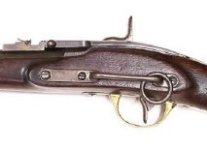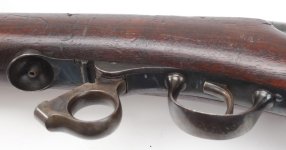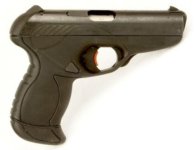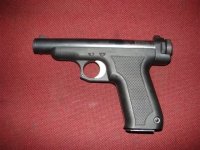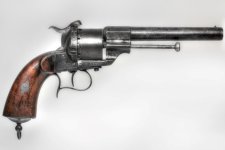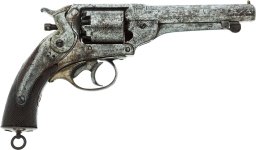You are using an out of date browser. It may not display this or other websites correctly.
You should upgrade or use an alternative browser.
You should upgrade or use an alternative browser.
What the heck
- Thread starter Ozzieman
- Start date
And another one for sgms
49 1866 Peabody Carbine
https://en.wikipedia.org/wiki/Peabody_action
The Peabody action was an early form of breechloading firearm action, where the heavy breechblock tilted downwards across a bolt mounted in the rear of the breechblock, operated by a lever under the rifle. The Peabody action most often used an external hammer to fire the cartridge.
The Peabody action was developed by Henry O. Peabody from Boston, Massachusetts, and was first patented on July 22, 1862. While the Peabody was not perfected in time for the American Civil War, a few were entered in the trials of 1864 with favorable reports.
Peabody carbines and rifles were made by the Providence Tool Company, Providence, Rhode Island; c. 1866–1871. The total production was, 112,000 for all models. Calibers were: .45 Peabody rimfire; .45-70 Government; .50 rimfire; 50-70; .433 Spanish; 10.4 mm rimfire Swiss. Barrel length carbine 20", rifle 33". Finish: Receiver casehardened, barrel blued, iron mountings, walnut stock.
The majority of Peabody's production was for foreign contracts, they were adopted by the militaries of Canada (3,000 pieces), Switzerland (15,000), France (33,000) Romania, Mexico and Spain during the later 1860s. In the United States, Connecticut purchased c. 1871–72, 2,000 Spanish Model rifles, Massachusetts 2,941 rifles and South Carolina purchased c. 1877 350 carbines.[citation needed] In 1919, Liberians received Peabody rifles through US arms sales.[1] The Liberian peabody rifles (600) were bought from the German government ( Woermann Co.) (they had been captured from the French army in the 1870-1871 war) with 400 mauser 1888 carbines and tonnes of gunpowder and 200,000 rounds of ammunition in 1910 during the war with the Grebo tribe. The cost was $20,000. (La resistance contre la occupation colonial en region forestiere: Guinee 1800-1930, Jean Marie Dore / The prophet HARRIS and the grebo rising, Haliburton, Gordon. Liberian Studies Journal)
The Peabody rifle was one of a half dozen different rifles that took part in the 1866 Swedish-Norwegian rifle trials, where it lost out to the Remington rolling block (which became the Remington M1867 in Swedish and Norwegian service) because of its greater complexity, with more parts than the Remington design.
The Swiss gunsmith Friedrich von Martini created an action that somewhat resembled Peabody's, but incorporated a hammerless internal striker and used a toggle moved by the striker to lock the action during firing. Mated to a barrel with rifling designed by Alexander Henry, the 1871 Martini–Henry would become the British Army's standard rifle for twenty years.
49 1866 Peabody Carbine
https://en.wikipedia.org/wiki/Peabody_action
The Peabody action was an early form of breechloading firearm action, where the heavy breechblock tilted downwards across a bolt mounted in the rear of the breechblock, operated by a lever under the rifle. The Peabody action most often used an external hammer to fire the cartridge.
The Peabody action was developed by Henry O. Peabody from Boston, Massachusetts, and was first patented on July 22, 1862. While the Peabody was not perfected in time for the American Civil War, a few were entered in the trials of 1864 with favorable reports.
Peabody carbines and rifles were made by the Providence Tool Company, Providence, Rhode Island; c. 1866–1871. The total production was, 112,000 for all models. Calibers were: .45 Peabody rimfire; .45-70 Government; .50 rimfire; 50-70; .433 Spanish; 10.4 mm rimfire Swiss. Barrel length carbine 20", rifle 33". Finish: Receiver casehardened, barrel blued, iron mountings, walnut stock.
The majority of Peabody's production was for foreign contracts, they were adopted by the militaries of Canada (3,000 pieces), Switzerland (15,000), France (33,000) Romania, Mexico and Spain during the later 1860s. In the United States, Connecticut purchased c. 1871–72, 2,000 Spanish Model rifles, Massachusetts 2,941 rifles and South Carolina purchased c. 1877 350 carbines.[citation needed] In 1919, Liberians received Peabody rifles through US arms sales.[1] The Liberian peabody rifles (600) were bought from the German government ( Woermann Co.) (they had been captured from the French army in the 1870-1871 war) with 400 mauser 1888 carbines and tonnes of gunpowder and 200,000 rounds of ammunition in 1910 during the war with the Grebo tribe. The cost was $20,000. (La resistance contre la occupation colonial en region forestiere: Guinee 1800-1930, Jean Marie Dore / The prophet HARRIS and the grebo rising, Haliburton, Gordon. Liberian Studies Journal)
The Peabody rifle was one of a half dozen different rifles that took part in the 1866 Swedish-Norwegian rifle trials, where it lost out to the Remington rolling block (which became the Remington M1867 in Swedish and Norwegian service) because of its greater complexity, with more parts than the Remington design.
The Swiss gunsmith Friedrich von Martini created an action that somewhat resembled Peabody's, but incorporated a hammerless internal striker and used a toggle moved by the striker to lock the action during firing. Mated to a barrel with rifling designed by Alexander Henry, the 1871 Martini–Henry would become the British Army's standard rifle for twenty years.
And another one for sgms
50 1858 JM Merrill Balto Carbine
https://en.wikipedia.org/wiki/Merrill_carbine
The Merrill carbine was a breechloader firearm designed by Baltimore, Maryland gunsmith and inventor James H. Merrill. It was one of several firearms either manufactured or altered by Merrill in fulfillment of contracts with the Union government during the U.S. Civil War.[1]
The carbine was a single-shot, percussion, breechloader used mainly by Union cavalry units. It used the .54 caliber Minie balls with paper cartridges which were loaded by lifting the top of the breech lever. The barrels were 22 1/8 inches and round with one barrel band.[1]
Models[edit]
The carbines were produced in two versions: First Type and Second Type. The First Type included a brass patchbox in the stock and had the breech lever secured by a flat, knurled latch. The Second Type was produced without the patchbox and had the breech lever secured with a rounded, button type latch.[1]
Other production[edit]
James H. Merrill produced or altered several other firearms which include: the Jenks-Merrill carbine; the Merrill rifle; and the Merrill, Latrobe, & Thomas Carbine.
Jenks-Merrill carbine[edit]
The Jenks-Merrill carbine was an altered firearm by James H Merrill. The carbine was a .54 caliber, single -shot, percussion, breechloader with a 24 1/4 inch round barrel and two barrel bands. Approximately 300 were modified for the U.S. Navy to use the action from the Merrill carbine.[1]
Merrill rifle[edit]
The Merrill rifle was produced from 1862-65 with a total quantity estimated at over 800. The rifle was a .54 caliber, single -shot, percussion, breechloader with an action identical to the Merrill Carbine, but with a 33 inch barrel, two barrel bands, and a lug for attaching a bayonet. It also had a brass patchbox similar to the First Type carbine. Serial numbers are in the "5000 - 14000" range. Of the rifles produced, 770 were purchased by the Union government during the Civil War. Most were issued to infantry regiments with small quantities issued to sharpshooters.[1]
Merrill, Latrobe, & Thomas carbine[edit]
The Merrill, Latrobe, & Thomas carbine was a carbine designed by James Merrill and manufactured by Samuel Remington of E. Remington and Sons in 1855. The carbine was a .58 caliber, single-shot, breechloader with a 21 inch round barrel and a single barrel band. One hundred and seventy were purchased by the U.S. Ordnance Department for trial use.[1][2]
50 1858 JM Merrill Balto Carbine
https://en.wikipedia.org/wiki/Merrill_carbine
The Merrill carbine was a breechloader firearm designed by Baltimore, Maryland gunsmith and inventor James H. Merrill. It was one of several firearms either manufactured or altered by Merrill in fulfillment of contracts with the Union government during the U.S. Civil War.[1]
The carbine was a single-shot, percussion, breechloader used mainly by Union cavalry units. It used the .54 caliber Minie balls with paper cartridges which were loaded by lifting the top of the breech lever. The barrels were 22 1/8 inches and round with one barrel band.[1]
Models[edit]
The carbines were produced in two versions: First Type and Second Type. The First Type included a brass patchbox in the stock and had the breech lever secured by a flat, knurled latch. The Second Type was produced without the patchbox and had the breech lever secured with a rounded, button type latch.[1]
Other production[edit]
James H. Merrill produced or altered several other firearms which include: the Jenks-Merrill carbine; the Merrill rifle; and the Merrill, Latrobe, & Thomas Carbine.
Jenks-Merrill carbine[edit]
The Jenks-Merrill carbine was an altered firearm by James H Merrill. The carbine was a .54 caliber, single -shot, percussion, breechloader with a 24 1/4 inch round barrel and two barrel bands. Approximately 300 were modified for the U.S. Navy to use the action from the Merrill carbine.[1]
Merrill rifle[edit]
The Merrill rifle was produced from 1862-65 with a total quantity estimated at over 800. The rifle was a .54 caliber, single -shot, percussion, breechloader with an action identical to the Merrill Carbine, but with a 33 inch barrel, two barrel bands, and a lug for attaching a bayonet. It also had a brass patchbox similar to the First Type carbine. Serial numbers are in the "5000 - 14000" range. Of the rifles produced, 770 were purchased by the Union government during the Civil War. Most were issued to infantry regiments with small quantities issued to sharpshooters.[1]
Merrill, Latrobe, & Thomas carbine[edit]
The Merrill, Latrobe, & Thomas carbine was a carbine designed by James Merrill and manufactured by Samuel Remington of E. Remington and Sons in 1855. The carbine was a .58 caliber, single-shot, breechloader with a 21 inch round barrel and a single barrel band. One hundred and seventy were purchased by the U.S. Ordnance Department for trial use.[1][2]
And we have a winner>>>>Scorch
61 Greene Model 1857 bolt action percussion rifle 53 cal.
http://underhammers.blogspot.com/2012/08/underhammer-bolt-action-rifles-this-is.html
The Greene breach loading rifle uses a oval bore that makes one turn in 50 inches. Patented byh Lt Col J, Durrel Green. The paper cartridge had the bullet behind the powder charge. It was the only under hammer used by the US military forces.
61 Greene Model 1857 bolt action percussion rifle 53 cal.
http://underhammers.blogspot.com/2012/08/underhammer-bolt-action-rifles-this-is.html
The Greene breach loading rifle uses a oval bore that makes one turn in 50 inches. Patented byh Lt Col J, Durrel Green. The paper cartridge had the bullet behind the powder charge. It was the only under hammer used by the US military forces.
Mike Irwin
Staff
South African Vektor.
Mike Irwin got that one, any one ever seen or held one?
100 Vector CP1 Victor
https://en.wikipedia.org/wiki/Vektor_CP1
Design[edit]
The CP1 pistol was intended as a concealed carry weapon for Law Enforcement and civilian use. It has an unusual, streamlined design with a polymer frame and an even more unusual safety, located at the front of the trigger-guard.[1]
In several reviews it was characterized as being a radically designed gun that looks like something straight out of a science fiction movie. These reviews stated that it has no sharp edges, and is about as "snag-proof" as any combat gun can ever be, and because of its design it is a surprisingly comfortable gun to shoot, which makes it feel very ergonomic.[2][3]
The pistol originally sold in the United States for a retail price of approximately $400. The pistol was marketed in Italy, where it was chambered for the 9×21mm IMI cartridge.[4]
The CP1 uses a gas-delayed blowback action with a gas cylinder located below the barrel. The trigger is a single action, internal hammer.[5]
A manual safety is located at the front of the trigger guard. To set on Safe, the button must be pressed rearward from the front; to set on Fire, the button must be pressed forward from inside the trigger guard.
The pistol is fitted with an automated trigger safety. Magazines are double stack; 10 & 12-round magazines are flush fit with the bottom of the grip, 13-round magazines have extended finger rests at the bottom.[4]
LIW was developing a .40 S&W caliber version of the CP1, to be known as the CP1N. It is unknown if the CP1N was ever actually produced.
Recall[edit]
In October 2000 a recall notice was issued for the Vektor CP1, because a small percentage of them had issues with the internal safety mechanisms and, when dropped, could accidentally fire. The recall states that the loaded gun can discharge if bumped or dropped. Information accompanying recall notices stated that the gun should not be loaded under any circumstances; although some firearms experts and enthusiasts may deem such recall as unnecessary for the mentioned defect, Denel probably took such steps to prevent any accident that may result in a lawsuit, as the primary export market of the Vektor CP1 pistol was the United States.
This recall ended promising sales in the USA, and terminated the life of this pistol on the market, although most of the CP1 pistols turned in from South African customers were indeed fixed and returned to their owners. The inability to fix and return the defective pistols from foreign markets was probably the reason behind Vektor's decision to pay $500 to anyone who turned in their gun, and to put the CP1 pistol out of production in 2001.
It is estimated that approximately 2000 of the handguns were sold in the United States prior to the recall.[6] Most of that number were turned in, and the pistols are now very rare in the United States. They are available in very limited numbers in South Africa and other countries.
100 Vector CP1 Victor
https://en.wikipedia.org/wiki/Vektor_CP1
Design[edit]
The CP1 pistol was intended as a concealed carry weapon for Law Enforcement and civilian use. It has an unusual, streamlined design with a polymer frame and an even more unusual safety, located at the front of the trigger-guard.[1]
In several reviews it was characterized as being a radically designed gun that looks like something straight out of a science fiction movie. These reviews stated that it has no sharp edges, and is about as "snag-proof" as any combat gun can ever be, and because of its design it is a surprisingly comfortable gun to shoot, which makes it feel very ergonomic.[2][3]
The pistol originally sold in the United States for a retail price of approximately $400. The pistol was marketed in Italy, where it was chambered for the 9×21mm IMI cartridge.[4]
The CP1 uses a gas-delayed blowback action with a gas cylinder located below the barrel. The trigger is a single action, internal hammer.[5]
A manual safety is located at the front of the trigger guard. To set on Safe, the button must be pressed rearward from the front; to set on Fire, the button must be pressed forward from inside the trigger guard.
The pistol is fitted with an automated trigger safety. Magazines are double stack; 10 & 12-round magazines are flush fit with the bottom of the grip, 13-round magazines have extended finger rests at the bottom.[4]
LIW was developing a .40 S&W caliber version of the CP1, to be known as the CP1N. It is unknown if the CP1N was ever actually produced.
Recall[edit]
In October 2000 a recall notice was issued for the Vektor CP1, because a small percentage of them had issues with the internal safety mechanisms and, when dropped, could accidentally fire. The recall states that the loaded gun can discharge if bumped or dropped. Information accompanying recall notices stated that the gun should not be loaded under any circumstances; although some firearms experts and enthusiasts may deem such recall as unnecessary for the mentioned defect, Denel probably took such steps to prevent any accident that may result in a lawsuit, as the primary export market of the Vektor CP1 pistol was the United States.
This recall ended promising sales in the USA, and terminated the life of this pistol on the market, although most of the CP1 pistols turned in from South African customers were indeed fixed and returned to their owners. The inability to fix and return the defective pistols from foreign markets was probably the reason behind Vektor's decision to pay $500 to anyone who turned in their gun, and to put the CP1 pistol out of production in 2001.
It is estimated that approximately 2000 of the handguns were sold in the United States prior to the recall.[6] Most of that number were turned in, and the pistols are now very rare in the United States. They are available in very limited numbers in South Africa and other countries.
Mike Irwin
Staff
You on a South African kick or something?
That's a Musgrave...
That's a Musgrave...
You on a South African kick or something?
Just a couple of interesting guns I found.
99 musgrave 9mm
https://en.wikipedia.org/wiki/Musgrave_Pistol
The Musgrave Pistol was a South African semi-automatic pistol with a layout and operation based on the Austro-Hungarian Roth-Steyr M1907 automatic pistols.[2] Designed for simplicity and minimal parts number, it failed to find commercial acceptance.[1]
Just a couple of interesting guns I found.
99 musgrave 9mm
https://en.wikipedia.org/wiki/Musgrave_Pistol
The Musgrave Pistol was a South African semi-automatic pistol with a layout and operation based on the Austro-Hungarian Roth-Steyr M1907 automatic pistols.[2] Designed for simplicity and minimal parts number, it failed to find commercial acceptance.[1]
Sorry Mike,,,,, yes it is another French gun
Another for sgms
55 1854 Lefaucheux Model
https://en.wikipedia.org/wiki/Lefaucheux_M1858
The Lefaucheux M1858 was a French military revolver, chambered for the 12 mm pinfire cartridge, based on a design by Casimir Lefaucheux. It was the first metallic-cartridge revolver adopted by a national government.[1] It was first fielded in 1858 by the French Navy, and though never issued by the French Army, it was used in limited numbers by the French Cavalry during their 1862 deployment to Mexico.[2] Models were also purchased by Spain, Sweden, Italy, Russia, and Norway. Along with those countries, both the U.S. Confederate and Federal forces also used them in the American Civil War.
The revolver was a six-shot open-framed design, which was loaded via a hinged gate on the right side of the frame, through which empty cartridges were also ejected via an ejector rod running along the barrel.
The American Civil War[edit]
During the American Civil War both sides fielded a wide variety of revolvers, including the M1858. The Federal forces purchased over 12,000 M1858 revolvers, primarily supplying them to cavalry forces in 1862. However, these pinfire revolvers were replaced in service later in the war as more Colt and Remington revolvers became available.[3] Among American troops, the pistol was often referred to as the "French" Tranter".[4]
Another for sgms
55 1854 Lefaucheux Model
https://en.wikipedia.org/wiki/Lefaucheux_M1858
The Lefaucheux M1858 was a French military revolver, chambered for the 12 mm pinfire cartridge, based on a design by Casimir Lefaucheux. It was the first metallic-cartridge revolver adopted by a national government.[1] It was first fielded in 1858 by the French Navy, and though never issued by the French Army, it was used in limited numbers by the French Cavalry during their 1862 deployment to Mexico.[2] Models were also purchased by Spain, Sweden, Italy, Russia, and Norway. Along with those countries, both the U.S. Confederate and Federal forces also used them in the American Civil War.
The revolver was a six-shot open-framed design, which was loaded via a hinged gate on the right side of the frame, through which empty cartridges were also ejected via an ejector rod running along the barrel.
The American Civil War[edit]
During the American Civil War both sides fielded a wide variety of revolvers, including the M1858. The Federal forces purchased over 12,000 M1858 revolvers, primarily supplying them to cavalry forces in 1862. However, these pinfire revolvers were replaced in service later in the war as more Colt and Remington revolvers became available.[3] Among American troops, the pistol was often referred to as the "French" Tranter".[4]

